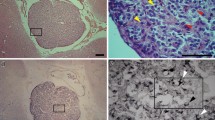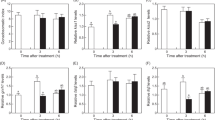Summary
A single melatonin injection was administered intraperitoneally to three avian species in two doses (250 and 500 μg · 100 g body wt−1). Norepinephrine (NE), epinephrine (E), and corticosterone (C) contents of the adrenal gland were measured spectrofluorometrically 0.5, 2, and 24 h after injection. The results showed that melatonin at the lower dose caused a decrease of NE content in bulbul (42%), babbler (52%), and pigeon (39%), while at the higher dose it resulted in a decrease of NE only in bulbul (51%) 0.5 h after treatment. Melatonin at the lower dose also caused a decrease of NE in bulbul (45%) and babbler (53%) 2 and 24 h, respectively, after treatment, while at the higher dose it resulted in an increase of NE in bulbul (82%) and a decrease of NE in babbler (44%) 24 h after injection.
Both low and high doses of melatonin resulted in a decrease of E content in bulbul (32–43%), babbler (34–43%), and pigeon (44–56%) 0.5 h after treatment, and a 34–46% decrease of E in bulbul and a 32–33% decrease of E in babbler 2 h after treatment. A 57% decrease of E was evident in pigeon with the lower dose of melatonin 2 h after injection. Melatonin at the higher dose caused a 67% increase of E in babbler and a 41% decrease of E in pigeon 24 h after administration. Melatonin at the lower dose resulted in an increase of C content in bulbul (70%), babbler (132%), and pigeon (69%) 0.5 h after treatment. A 60% increase of C was evident in pigeon following the lower dose of melatonin 24 h after injection. Melatonin at the higher dose resulted in an increase of C in the bulbul of 72% and 86% at 0.5 and 24 h, respectively, after treatment. The results indicate that melatonin produces significant changes of NE, E, and C contents in three avian species. The lower dose appears to be more effective in changing NE and C content.
Similar content being viewed by others
Abbreviations
- C :
-
corticosterone
- CA :
-
catecholamine
- DBH :
-
dopamine β-hydroxylase
- E :
-
epinephrine
- NE :
-
norepinephrine
References
Banerji TK, Quay WB (1976) Adrenal dopamine-beta-hydroxylase activity: 24-hour rhythmicity and evidence for pineal control. Experientia 32:253–255
Banerji TK, Quay WB (1986) Effects of melatonin on adrenomedullary dopamine-beta-hydroxylase activity in golden hamsters: evidence for pineal and dose dependencies. J Pineal Res 3:397–404
Banerji TK, Quay WB, Kachi T (1978) Hypothalamic dopamine-beta-hydroxylase activity: fluctuation with time of day and their modifications by intracranial surgery, adrenalectomy, and pinealectomy. Neurochem Res 3:281–293
Banerji TK, Kachi T, Quay WB (1980) Adrenal and hypothalamic dopamine-beta-hydroxylase activity in the hamster: evidence for species-distinctive day-night and post-pinealectomy differences in activity. J Neurosci Res 5:371–378
Cox RH Jr, Perhach JL Jr (1973) A sensitive, rapid, and simple method for the simultaneous spectrophotofluorometric determinations of norepinephrine, dopamine, 5-hydroxy-tryptamine, and 5-hydroxy-indole-acetic acid in discrete areas of brain. J Neurochem 20:1777–1780
Csaba G, Nagy SU (1973) The regulatory role of the pineal gland on the thyroid gland, adrenal medulla, and the islets of Langerhans. Acta Biol Med Ger 31:617–619
Glick D, von Redlich D, Levine S (1964) Fluorometric determination of corticosterone and cortisol in 0.02–0.05 milliliters of plasma or submilligram samples of adrenal tissue. Endocrinology 74:653–655
John TM, George JC (1990) Physiological responses of melatonin-implanted pigeons to changes in ambient temperature. In: Riklis E (ed) Photobiology: the science and its applications. Plenum Press, New York, in press
John TM, Viswanathan M, George JC, Scanes CG (1990) Influence of chronic melatonin implantation on circulating levels of catecholamines, growth hormone, thyroid hormones, glucose, and free fatty acids in the pigeon. Gen Comp Endocrinol 79:226–232
Kachi T, Banerji TK, Quay WB (1979) Daily rhythmic changes in synaptic vesicle contents of nerve endings on adrenomedullary adrenaline cells, and their modification by pinealectomy and sham-operations. Neuroendocrinology 28:201–211
Kachi T, Banerji TK, Quay WB (1980) The invagination complex in nerve endings on adrenomedullary adrenaline cells: quantitative ultrastructural description, and analysis of changes with time-of-day and their modifications by sham-surgery and pinealectomy. J Autonom Nerv Syst 2:241–248
Kachi T, Banerji TK, Quay WB (1984) Quantitative cytological analysis of functional changes in adrenomedullary chromaffin cells in normal, sham-operated, and pinealectomized rats in relation to time-of-day. I. Nucleolar size. J Pineal Res 1:31–49
Kachi T, Banerji TK, Quay WB (1985) Quantitative ultrastructural analysis of differences in exocytosis number in adrenomedullary adrenaline cells of golden hamsters related to time-of-day, pinealectomy, and intracellular region. J Pineal Res 2:253–269
Kachi T, Banerji TK, Quay WB (1988a) Quantitative cytological analysis of functional changes in adrenomedullary chromaffin cells in normal, sham-operated, and pinealectomized rats in relation to time-of-day: II. Nuclear-cytoplasmic ratio, nuclear size, and pars granulosa of nucleolus. J Pineal Res 5:141–159
Kachi T, Banerji TK, Quay WB (1988b) Quantitative cytological analysis of functional changes in adrenomedullary chromaffin cells in normal, sham-operated, and pinealectomized rats in relation to time-of-day: III. Nuclear density. J Pineal Res 5:527–534
Kachi T, Quay WB, Banerji TK, Imagawa T (1990) Effects of pinealectomy on the mitotic activity of adrenomedullary chromaffin cells in relation to time-of-day. J Pineal Res 8:21–34
Laverty R, Taylor KM (1968) The fluorometric assay of catecholamines and related compounds: improvements and extensions to the hydroxyindole technique. Anal Biochem 22:269–279
Mahata SK, Mandal A, Ghosh, A (1988) Influence of age and splanchnic nerve on the action of melatonin in the adrenomedullary catecholamine content and blood glucose level in the avian group. J Comp Physiol B 158:601–607
McKeown BA, John TM, George JC (1975) Diurnal variation in effects of melatonin on plasma growth hormone and glucose in the pigeon. Endocrinol Exp 9:263–268
Menendez-Pelaez A, Buzzell GR, Nonaka KO, Reiter RJ (1990) In vivo administration of isoproterenol or forskolin during the light phase induces increases in the melatonin content of the Syrian hamster pineal gland without a rise in N-acetyltransferase activity. Neurosci Lett 110:314–318
Pang SF, Ralph CL, Reilly DP (1974) Melatonin in the chicken brain: its origin, diurnal variation, and regional distribution. Gen Comp Endocrinol 22:499–506
Petrescu C, Simionescu N (1970) Cercetari experimentale privind relatille dintre pineala si medullosuprarenala la sobulanul alb. St Cercet Endocrinol 21:339–343
Ralph CL, Binkley S, MacBride SE, Klein DC (1975) Regulation of pineal rhythms in chicken; effects of blinding, constant light, constant dark, and superior cervical ganglionectomy. Endocrinology 97:1373–1378
Reiter RJ (1983) The role of light and age in determining melatonin production in the pineal gland. In: Axelrod J, Fraschini F, Velo GP (eds) The pineal gland and its endocrine role. Plenum Press, New York, pp 227–241
Reiter RJ, Vaughan GM, Oaknin S, Troiani ME, Cozzi B, Li K (1987) Norepinephrine or isoproterenol stimulation of pineal N-acetyltransferase activity and melatonin content in the Syrian hamster is restricted to the second half of the daily dark phase. Neuroendocrinology 45:249–256
Snedecor GW, Cochran WG (1967) Statistical methods, 6th ed. Iowa State University Press, Ames, Iowa
Takahashi JS, Hamm H, Menaker M (1980) Circadian rhythms of melatonin release from individual superfused chicken pineal glands in vitro. Proc Natl Acad Sci USA 77:2319–2322
Troiani ME, Reiter RJ, Vaughan MK, Oaknin S, Vaughan GM (1988) Swimming depresses nighttime melatonin content without changing N-acetyltransferase activity in the rat pineal gland. Neuroendocrinology 47:55–60
Viswanathan M, Hissa R, George JC (1986) Suppression of sympathetic nervous system by short photoperiod and melatonin in the Syrian hamster. Life Sci 38:73–79
Author information
Authors and Affiliations
Rights and permissions
About this article
Cite this article
Mahata, S.K., De, K. Effect of melatonin on norepinephrine, epinephrine, and corticosterone contents in the adrenal gland of three avian species. J Comp Physiol B 161, 81–84 (1991). https://doi.org/10.1007/BF00258750
Accepted:
Issue Date:
DOI: https://doi.org/10.1007/BF00258750




